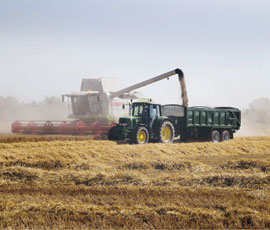Harvest roundup: Full speed ahead

The first decent few days of dry weather in a row has brought combines out in force, with most farmers likely to make excellent progress over the weekend.
In Hertfordshire, Alistair Pinkerton had finished combining oilseed rape at Blackbird’s Farm, Aldenham, and was now waiting for his wheat to ripen.
“The rape was very mixed – we had very droughty conditions in the spring, followed by too much wet, and it only averaged 3.3t/ha, which is below our norm.”
Solstice winter wheat was about three days away from combining, and looked dreadful, he said.
However, in Kent, Bill Harbour was combining Gallant milling wheat at Gosmere Farm, Sheldwich, today (10 August), and was pleased with the results.
So far he had cut 10.45ha, which had produced 90t. “As a second wheat that’s got to be good. And it looks like it will have a good protein content.
“But the bushel weight is pretty grim, in the low 70s, which seems to be standard around here.”
In the South West, many farmers were finishing up their winter barley today, with oilseed rape harvest now halfway through.
“Winter barley yields have been lower than last year, at between 5t and 7.4t/ha,” said Agrii agronomist Mike Horsburgh.
“Two row quality is better than six rows, which have reverted back to their very poor bushel weights.”
Oilseed rape yields had dropped back from last year’s highs to a more normal average of between 2.5t and 3.9t/ha, he said.
Of the rapeseed cut so far across the country, yields were generally lower than last year, and many crops were suffering badly from seed shedding and high admixtures, said David Leaper, arable technical manager at Openfield.
Oil contents were lower than last year, at 42-43%. “And we may see crops with oil contents below 40% for the first time in many years.”
Given the suddenly rapid ripening and uneven crops, seed shedding was widespread, with yield losses of up to 20% on the cards for many farmers, he said.
Meanwhile, drought in the US had led the Department of Agriculture to slash its estimate of maize production by a further 55m tonnes, to 329m tonnes – its lowest level since 2006/07.
Yields were pegged at 7.73t/ha, the lowest since 1995/96, putting the production estimate some 27% below the USDA’s original June figure of 375m tonnes.

